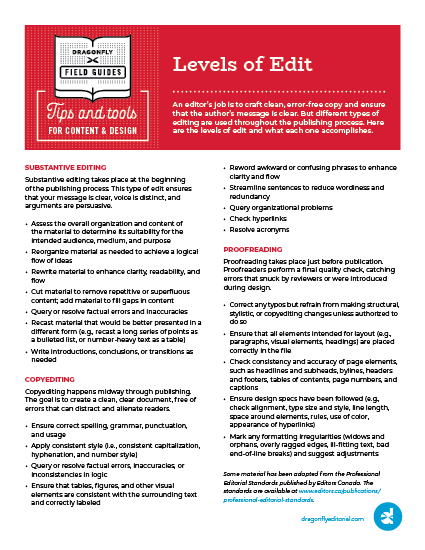Editing is critical to any successful publication — whether it’s a website, white paper, newsletter, or blog. An editor’s job is to craft clean, error-free copy and ensure that the author’s message is clear. Different types of editing are used throughout the publishing process. Here’s a guide to the levels of edit and what each one accomplishes.
SUBSTANTIVE EDITING
Substantive editing takes place at the beginning of the publishing process. This type of edit ensures that your message is clear, voice is distinct, and arguments are persuasive.
- Assess the overall organization and content of the material to determine its suitability for the intended audience, medium, and purpose
- Reorganize material as needed to achieve a logical flow of ideas
- Rewrite material to enhance clarity, readability, and flow
- Cut material to remove repetitive or superfluous content; add material to fill gaps in content
- Query or resolve factual errors and inaccuracies
- Recast material that would be better presented in a different form (e.g., recast a long series of points as a bulleted list, or number-heavy text as a table)
- Write introductions, conclusions, or transitions as needed
COPYEDITING
Copyediting happens midway through publishing. The goal is to create a clean, clear document, free of errors that can distract and alienate readers.
- Ensure correct spelling, grammar, punctuation, and usage
- Apply consistent style (i.e., consistent capitalization, hyphenation, and number style)
- Query or resolve factual errors, inaccuracies, or inconsistencies in logic
- Ensure that tables, figures, and other visual elements are consistent with the surrounding text and correctly labeled
- Reword awkward or confusing phrases to enhance clarity and flow
- Streamline sentences to reduce wordiness and redundancy
- Query organizational problems
- Check hyperlinks
- Resolve acronyms
PROOFREADING
Proofreading takes place just before publication. Proofreaders perform a final quality check, catching errors that snuck by reviewers or were introduced during design.
- Correct any typos but refrain from making structural, stylistic, or copyediting changes unless authorized to do so
- Ensure that all elements intended for layout (e.g., paragraphs, visual elements, headings) are placed correctly in the file
- Check consistency and accuracy of page elements, such as headlines and subheads, bylines, headers and footers, tables of contents, page numbers, and captions
- Ensure design specs have been followed (e.g., check alignment, type size and style, line length, space around elements, rules, use of color, appearance of hyperlinks)
- Mark any formatting irregularities (widows and orphans, overly ragged edges, ill-fitting text, bad end-of-line breaks) and suggest adjustments
Some material has been adapted from the Professional Editorial Standards published by Editors Canada.


